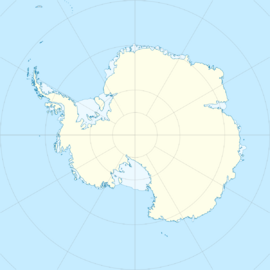Place:Dome F
Dome Fuji Station | |
|---|---|
Antarctic base | |
Location of Dome Fuji Station in Antarctica | |
| Coordinates: [ ⚑ ] : 77°18′59″S 39°42′04″E / 77.316285°S 39.701049°E | |
| Country | |
| Location in Antarctica | Queen Maud Land Antarctica |
| Administered by | National Institute of Polar Research (Japan) |
| Established | Script error: No such module "Date time". |
| Elevation | 3,700 m (12,100 ft) |
| UN/LOCODE | AQ DMF |
| Type | Seasonal |
| Period | Summer |
| Status | Temporarily closed[1] |
| Website | National Institute of Polar Research |
Dome Fuji Skiway | |||||||||||
|---|---|---|---|---|---|---|---|---|---|---|---|
| Summary | |||||||||||
| Airport type | Private | ||||||||||
| Location | Queen Maud Land | ||||||||||
| Elevation AMSL | 12,354 ft / 3,765 m | ||||||||||
| Coordinates | [ ⚑ ] 77°19′00″S 39°42′00″E / 77.316667°S 39.700000°E | ||||||||||
| Map | |||||||||||
| Runways | |||||||||||
| |||||||||||

Dome Fuji (ドームふじ Dōmu Fuji), also called Dome F or Valkyrie Dome, is an Antarctic base located in the eastern part of Queen Maud Land at [ ⚑ ] 77°30′S 37°30′E / 77.5°S 37.5°E. With an altitude of 3,810 metres (12,500 ft) above sea level, it is the second-highest summit or ice dome of the East Antarctic Ice Sheet and represents an ice divide. Dome F is the site of Dome Fuji Station, a research station operated by Japan .
Discovery and naming
Dome Fuji is an ice dome rising to about 3,700 metres (12,100 ft) in the eastern part of Queen Maud Land. It is the highest elevation in Queen Maud Land and also the highest elevation within the claims of Norway . In 1963–1964, a Soviet Antarctic Expedition oversnow traverse crossed the northern part of the dome at an elevation of over 3,600 metres (11,800 ft).
Environment
Owing to its location on the Antarctic Plateau and the high elevation, Dome Fuji is one of the coldest places on Earth. Temperatures rarely rise above −30 °C (−20 °F) in summer and can drop to −80 °C (−110 °F) in winter. The annual average air temperature is −54.3 °C (−65.7 °F). The climate is that of a cold desert, with very dry conditions and an annual precipitation of about 25 millimetres (1 in) of water equivalent, which falls entirely as ice crystals.[2]
Dome Fuji Station
Dome Fuji Station (ドームふじ基地 Dōmu Fuji Kichi) was established as Dome Fuji Observation Base (ドームふじ観測拠点 Dōmu Fuji Kansoku Kyoten) in January 1995. Its name was changed to "Dome Fuji Station" on April 1, 2004. Located at [ ⚑ ] 77°19′S 39°42′E / 77.317°S 39.7°E, it is separated from Showa Station by about 1,000 kilometres (620 mi).
Glaciology
Deep ice core drilling at Valkyrie Dome was started in August 1995, and in December 1996 a depth of 2,503 metres (8,212 ft) was reached. This first core covers a period back to 340,000 years.[3][4]
The core quality from the Dome Fuji Station is excellent, even in the brittle zone from 500 to 860 metres (1,640 to 2,820 ft) deep, where the ice is fragile during the in situ core-cutting procedure.[5]
A second deep core was started in 2003. Drilling was carried out during four subsequent austral summers from 2003–2004 until 2006–2007, and by then a depth of 3,035.22 metres (9,958.1 ft) was reached. The drill did not hit the bedrock, but rock particles and refrozen water have been found in the deepest ice, indicating that the bedrock is very close to the bottom of the borehole. This core greatly extends the climatic record of the first core, and according to a first, preliminary dating, it reaches back 720,000 years.[6] The ice of the second Valkyrie Dome core is therefore the second-oldest ice ever recovered, outranged only by the EPICA Dome C core.
See also
- List of Antarctic research stations
- List of Antarctic field camps
- Airports in Antarctica
- Troll (research station)
- Asuka Station (Antarctica)
- Mizuho Station (Antarctica)
- Showa Station (Antarctica)
- Vostok Station
- Climate of Antarctica
References
- ↑ National Institute of Polar Research
- ↑ Watanabe, O.; and 11 others (2003). "General tendencies of stable isotopes and major chemical constituents of the Dome Fuji deep ice core". Tokyo, Japan: National Institute of Polar Research. pp. 1–24.
- ↑ Dome-F Deep Coring Group (1998). "Deep ice-core drilling at Dome Fuji and glaciological studies in east Dronning Maud Land, Antarctica". Annals of Glaciology 27: 333–337. doi:10.3189/1998AoG27-1-333-337. Bibcode: 1998AnGla..27..333D.
- ↑ Kawamura, K.; and 17 others (2007). "Northern Hemisphere forcing of climatic cycles in Antarctica over the past 360,000 years". Nature 448 (7156): 912–916. doi:10.1038/nature06015. PMID 17713531. Bibcode: 2007Natur.448..912K.
- ↑ "The paleoclimate record in the ice core at Dome Fuji station, East Antarctica". Annals of Glaciology 29 (1): 176–8. Jun 1999. doi:10.3189/172756499781821553.
- ↑ Motoyama, H. (2007). "The second deep ice coring project at Dome Fuji, Antarctica". Scientific Drilling 5: 41–43. doi:10.5194/sd-5-41-2007. Bibcode: 2007SciDr...5...41M.
External links
- Dome Fuji Deep Ice Coring Project
- Dome Fuji page of the World Data Center (WDC) for Paleoclimatology, contains downloadable data for the first core
- National Institute of Polar Research, Tokyo, Japan
- Institute of Low Temperature Science, Sapporo, Japan
- COMNAP Antarctic Facilities
- COMNAP Antarctic Facilities Map


